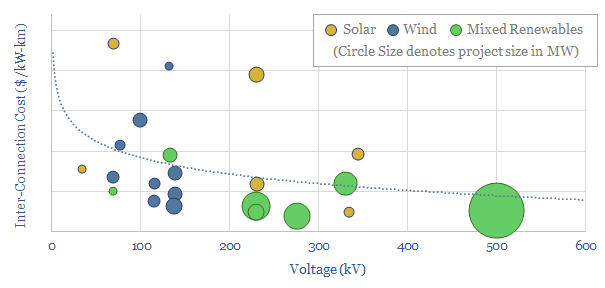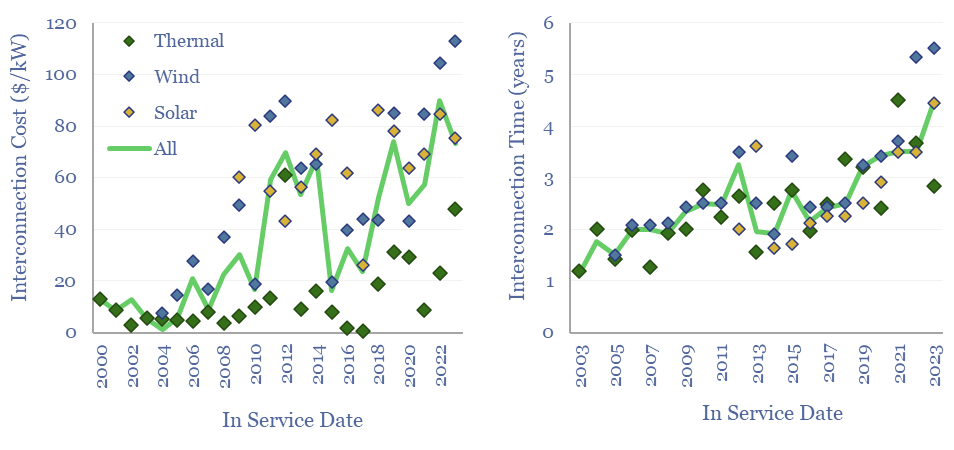The cost of grid connection is shaping up to be a major bottleneck for the continued acceleration of new energies. A good baseline is to expect $100-300/kW of grid inter-connection costs, or $3-10/kW-km, over a typical distance of 10-70 km. But the requirement to fund network upgrade costs can push grid connections to cost more than developing renewables projects themselves?!
The best resource we have ever seen into the cost of grid interconnection for different power generation sources in North America is compiled by Lawrence Berkeley Laboratory. Several separate data-files were last released in mid-2023, and we have aggregated them here, then added our own analytics and observations.
The cost of grid interconnection has averaged $138/kW across 3,382 projects in the database, which breaks down as $51/kW for thermal power plants, $138/kW for wind projects and $167/kW for solar projects. As a rule of thumb, 25% of the cost is direct cost, while 75% is the requirement to fund network upgrades, per our note here.
The cost of grid interconnection has increased substantially over time. Across the subset of projects that did ultimately connected to the grid (i.e., excluding projects that withdrew their proposals, sometimes due to prohibitively high grid connection costs), the average cost has increased by 4x from $25/kW in the 2000s to $110/kW in 2022-23.

The timelines for grid interconnection have also approximately doubled since the mid-2000s, and projects coming into service in 2023 required over 4-years from their initial entry to the queue. Wind and solar projects take substantively longer, simply due to the sheer numbers of projects (789 solar and wind projects joined the queue at peak in 2021!). We have also written a separate article on grid interconnection times.

There is excellent granularity in the data-file, ranging from small projects with <$1/kW interconnection costs to 100 wind and solar projects where the quoted costs of interconnect were over $1,000/kW, or in other words, the cost of the grid connection was as high as the wind project or solar project itself. In our view, avoiding high network upgrade costs is the key reasons for co-development of renewables plus batteries.

What is missing from the LBL data-set is detail on the distances, voltages and other commentary. Hence this data-file assesses twenty case studies of renewables assets in North America, based on published inter-connection documents.
Costs are highly variable. But a good baseline is to expect $100-300/kW of grid inter-connection costs, or $3-10/kW-km, over a 10-70 km typical distance (including the length of downstream lines that must be upgraded). Larger and higher voltage projects have lower tie-in costs.

Again it was surprising how vastly the ranges can vary. The lowest-cost tie-in was $25/kW, tying in a solar asset to a 230kV power line with spare capacity that is a mere 1-mile away. Whereas the highest-cost tie-in was $1,250/kW (i.e., more than the 40MW solar project itself!) where the asset owner was asked to contribute an eye-watering c$50M to cover the costs of upgrading 500km of high-voltage transmission lines downstream of the inter-connection point.
We updated the data-file in early-2024, with recent case studies bemoaning excessively long interconnection times, in North America and Europe. Interconnecton costs and timelines have approximately doubled in the past decade. We think power grids are shaping up to be the biggest bottleneck in the energy transition
